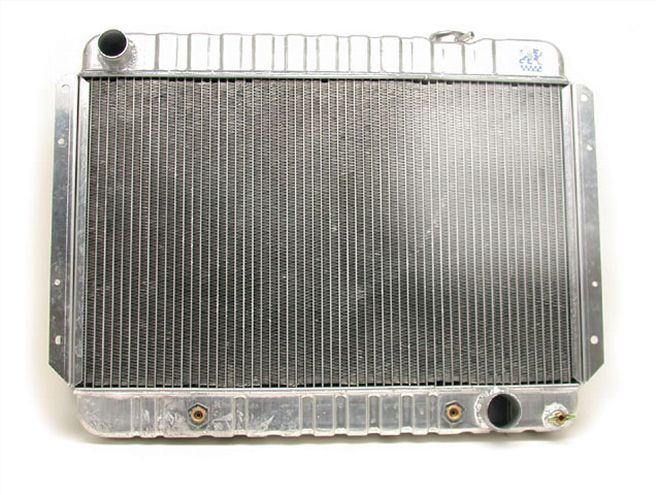

When you're planning out the stages of your car buildup, the cooling system probably isn't a particularly thrilling part of the investment. So if you're in the market for a new radiator, you've probably noticed that there are a myriad of models available to fit your car. Will a two-row aluminum work as well as a four-core copper-brass radiator? Which material cools better, and why? We spoke with the folks at Griffin Radiators, who deconstructed the marketing hype and broke down a little cooling science for your benefit (as well as ours).
Just like your engine, a radiator needs air to function. It's a water-to-air heat exchanger, so it requires air to flow past a sufficiently large network of tubes that contain flowing engine coolant. The tubes make contact with thin metal fins to further increase the surface area available for cooling. Of course, more surface area means that more of the coolant's heat can be dissipated. The ideal radiator, then, would be built from highly conductive metal with large diameter tubes and maximum tube-to-fin contact, and it would be able to pass air efficiently with minimal restriction. Copper-brass conducts heat considerably better than aluminum does. Bigger tubes and more fins increase surface area. So why don't we build a five-core copper-brass radiator with huge tubes and a bunch of cooling fins? The limitations are material strength, weight, and airflow.
Copper-brass alloy isn't as strong as aluminum, so its tubes are more susceptible to blowing out under even the relatively mild pressure generated by a cooling system. Building a copper-brass radiator with a larger, more efficient 1-inch tube diameter requires thickening the tube wall to 0.015 inch-twice as thick as is necessary on a 51/48-inch-diameter tube. That means the larger tubes weigh over three times as much as the smaller tubes-not good! The compromise comes from building the tubes out of aluminum. An aluminum radiator using 1-inch-wide tubes with 0.016-inch wall thickness is 60 percent lighter than the same copper-brass radiator. The 1-inch-wide tubes increase tube-to-fin contact and cooling capacity by roughly 25 percent over a radiator built with 11/42-inch tubes. The net result? Griffin claims that a two-row aluminum radiator with 1-inch tubes will cool as well as a five-row copper-brass radiator with 11/42-inch tubes. That frees up some extra room under the hood, and the two-row design allows less restricted airflow through the core. More air equals more cooling.
Sure, the theory works, but is it enough to justify shelving your stock copper-brass radiator for a slick, shiny aluminum piece? We've certainly been able to cool our big-blocks just fine using a stock-appearing four-core copper-brass radiator like U.S. Radiator's Desert Cooler. In fact, our U.S. Radiator-cooled 455ci Pontiac has yet to eclipse 200 degrees F. Would the Pontiac run any cooler with a trick aluminum radiator? Griffin feels that a well-designed aluminum radiator cools better. These days, aluminum radiators are the trend in the aftermarket as well as in OEM production. But it's hard to say how much better an aluminum radiator will cool a unique car. Griffin explained that aluminum radiators do have more distinct advantages in racing, where damage resistance and ultra-high-pressure cooling systems are commonplace. They can handle a 30-psi pressurized cooling system, and a special high-temperature epoxy reinforcement process provides additional strength to the welded tubes. That's a bit much to ask from a soldered copper-brass radiator.
Custom-fit aluminum radiators are still pretty steeply priced, but universal-fit aluminum racing radiators are very competitive with copper-brass replacements. Griffin's racing radiators are MIG-welded, and while they don't look as nice as the company's TIG'd custom-fit radiators, they should function just as well provided you're up to a little fabrication work to install them. The real penalty is a paltry 30-day warranty, compared to the two-year guarantee on all Griffin's custom-fit radiators. Provided there are good engine-to-frame grounds to prevent electrolysis, and assuming you change your coolant every year, Griffin says either model should keep you cool for years.
So what should you take from this? If you're beating the living daylights out of your car, whether it's in the form of a 140-mph blast on the Silver State Challenge or a 7,000-rpm downshift before turn five of Elkhart Lake Raceway, you may need to exploit the high-coolant-pressure handling and vibration-fatigue resistance of a stout aluminum radiator. But whether you like the high-tech look of aluminum or the resto/sleeper stealth of copper-brass, either (when properly selected) should be able to cool your street car, provided it's coupled with a good fan and shroud.